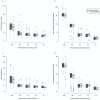Cardiovascular rhythmicity in overweight and obese children
- PMID: 37527530
- PMCID: PMC10726656
- DOI: 10.1590/2175-8239-JBN-2022-0138en
Cardiovascular rhythmicity in overweight and obese children
Abstract
Introduction: Obesity is thought to play a role in the disruption of cardiac rhythmicity in obese children, but this is mostly an unexplored field of investigation. We aimed to evaluate the impact of overweight and obesity on circadian and ultradian cardiovascular rhythmicity of prepubertal children, in comparison with normal weight counterparts.
Methods: We performed a cross sectional study of 316 children, followed in the birth cohort Generation XXI (Portugal). Anthropometrics and 24-hour ambulatory blood pressure were measured and profiles were examined with Fourier analysis for circadian and ultradian blood pressure (BP) and heart rate (HR) rhythms.
Results: Overweight/obese children presented more frequently a non-dipping BP pattern than normal weight counterparts (31.5% vs. 21.6%, p = 0.047). The prevalence of 24-hour mean arterial pressure (MAP) and 8-hour HR rhythmicity was significantly lower in obese children (79.3% vs. 88.0%, p = 0.038 and 33.3% vs. 45.2%, p = 0.031, respectively). The prevalence of the remaining MAP and HR rhythmicity was similar in both groups. No differences were found in the median values of amplitudes and acrophases of MAP and HR rhythms.
Discussion: The alterations found in rhythmicity suggest that circadian and ultradian rhythmicity analysis might be sensitive in detecting early cardiovascular dysregulations, but future studies are needed to reinforce our findings and to better understand their long-term implications.
Introdução:: Acredita-se que a obesidade desempenhe um papel na desregulação da ritmicidade cardíaca em crianças obesas, mas esse é um campo de investigação ainda pouco explorado. O objetivo deste trabalho foi avaliar o impacto do sobrepeso e da obesidade na ritmicidade cardiovascular circadiana e ultradiana de crianças pré-púberes, em comparação com crianças com peso normal.
Métodos:: Realizamos um estudo transversal com 316 crianças, acompanhadas na coorte de nascimentos Geração XXI (Portugal). Foram medidos dados antropométricos e a pressão arterial ambulatorial de 24 horas, e os perfis foram examinados com uma análise de Fourier para ritmos circadianos e ultradianos de pressão arterial (PA) e frequência cardíaca (FC).
Resultados:: Crianças com sobrepeso/obesidade apresentaram mais frequentemente um padrão de PA não-dipper em comparação com crianças com peso normal (31,5% vs. 21,6%; p = 0,047). A prevalência da pressão arterial média (PAM) de 24 horas e da ritmicidade da FC de 8 horas foi significativamente menor em crianças obesas (79,3% vs. 88,0%; p = 0,038 e 33,3% vs. 45,2%; p = 0,031, respectivamente). A prevalência das restantes ritmicidades da PAM e da FC foi semelhante em ambos os grupos. Não foram encontradas diferenças nos valores medianos das amplitudes e acrofases dos ritmos de PAM e FC. Discussão: As alterações encontradas na ritmicidade sugerem que a análise da ritmicidade circadiana e ultradiana pode ser sensível na detecção de desregulações cardiovasculares precoces, mas são necessários novos estudos para reforçar nossos achados e entender melhor suas implicações a longo prazo.
Conflict of interest statement
The authors have no conflicts of interest to declare.
Figures


References
-
- Abarca-Gómez L, Abdeen ZA, Hamid ZA, Abu-Rmeileh NM, Acosta-Cazares B, Acuin C, et al. Worldwide trends in body-mass index, underweight, overweight, and obesity from 1975 to 2016: a pooled analysis of 2416 population-based measurement studies in 128.9 million children, adolescents, and adults. Lancet. 2017;390(10113):2627–42. doi: 10.1016/S0140-6736(17)32129-3. - DOI - PMC - PubMed
MeSH terms
LinkOut - more resources
Full Text Sources
Medical

